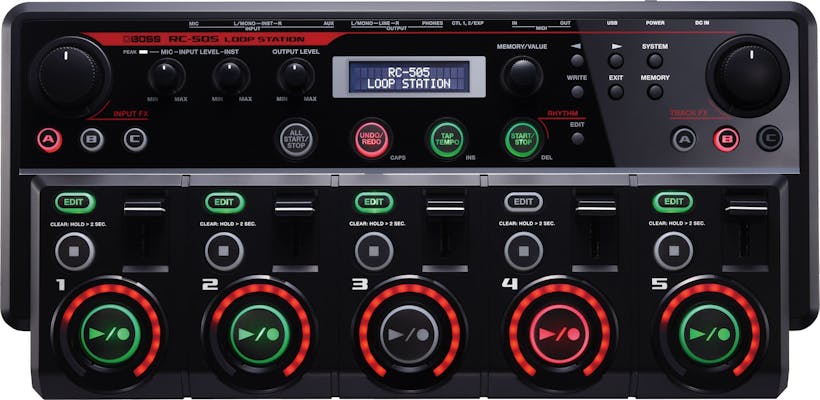Boss RC-505 Loop Station - Test & Review
The effects specialists of the Japanese studio equipment label Roland have a history of releasing classics, that became irreplaceable for musicians. With the RC-505 Loop Station, they added a promising looper for desktop use in the premium segment. But what is this device, that is designed for manual control, really able to do? Who will benefit from this supposed all-rounder with five separate tracks - and what are its technical features? We tested it for you.
- The RC-505 Loop Station and Where It Is Used
- Handling and Technical Features
- The Most Important Technical Details of the Boss Loop Station RC-505
- The Five Stereo Tracks of the Loop Station
- RC-505 Loop Station with Two Independent Effect Blocks
- The RC-505 as USB Storage Device and MIDI/Audio Interface
- Conclusion
Update: The Boss RC-505 is no longer available. If you want to learn more about the successor of the RC-505, take a look at our review of the Boss RC-505MKII. If you want to buy the RC-505MKII simply click the links above.
The RC-505 Loop Station and Where It Is Used
The question about a fitting application area for the Boss RC-505 Loop Station is easy to answer. Whether you're a keyboardist, a singer, a beatboxer, a DJ or an enthusiastic hobby musician who wants to boost your videos and streams with vibrant creativity, this looper, loaded with a variety of live improvisation features, might be the perfect choice for you - whether you want to work with it in your living room, studio or on stage, or use it to produce jazz, synth pop or hip-hop.
The RC-505 Loop Station is a about 40 centimetres wide and 20 centimetres deep and - unlike classic devices such as the RC-300 - not tailor-made for foot operation. However, external foot switches and expression pedals can be connected without any difficulty. Therefore, it is possible for solo instrumentalists to use the Loop Station to work on their solos.
As the musical application area is set, it is now time to explore the technical capabilities of the tabletop looper.
Handling and Technical Features
First things first: From the first moment of using it, the RC-505 Loop Station does not put any discouraging obstacles in the way of your own creativity when it comes to operating the device. From our point of view, the range of functions is as enormous, as you would expect from a professional device. However, most of the controls are self-explanatory. Details and initial ambiguities are eliminated by the enclosed, comprehensive manual.
The Most Important Technical Details of the Boss Loop Station RC-505
- width of 42, a height of 6.8 and a depth of 21 centimetres
- weight: approx. 1,4 kg
- case material: plastic, colour black.
Connections (inputs/outputs) for instruments, microphones and other audio devices:
- power plug
- USB port to use as audio interface or WAV files import & export
- MIDI In & Out
- jack for foot switch/expression pedal
- headphone stereo jack output
- two instrument inputs
- XLR microphone input (switchable phantom power)
- analogue audio input - 3.5mm stereo jack
- two audio jack outputs (left/mono, right)
- cut-out: Kensington-Lock
The Five Stereo Tracks of the Loop Station
The undoubted heart of the RC-505 are the five independent stereo loop tracks - the maximum we've known of up to now was three. They're individually operated by a sensitive rubber button and a short volume fader. With the former, the loops can be intuitively controlled, i.e. recorded, played back or mixed. Even though the volume fader only has a 20mm control range, it's perfect to fade out individual loops. In the beginning, we found the many different lights to be annoying. But if you know how to understand the light signals, the signal colours prove to be extremely helpful. The rubber buttons indicate the current status with their colour (green light means playback, etc.) - so you can always keep an eye on the most important information.
In addition to the intuitive handling, each loop track offers its own playback modes and various settings for tempo, effects and synchronization - or in a nutshell, for entire phrase sets. Another important aspect is the large memory space. The overall recording time for all five modules is around 3 hours - at a quality of 16-bit, stereo and 44.1 kHz. Each track has 99 memory slots, the number of overdubs is unlimited (until the memory of 2GB is full).
RC-505 Loop Station with Two Independent Effect Blocks
The five separate tracks of this Loop Station lay the foundation for creative looping . Thanks to the independent input and output effects - controlled left and right in the upper half of the control panel - free improvisation may begin. The technical possibilities offered by the RC-505 are impressive.
Structured into three effect blocks, the Loop Station provides you with a rich spectrum of effect types - for example:
- Reverb
- EQ
- Delay
- Flanger
- Beat Shift
- Vocal Distortion
The most important parameters of the effects, such as intensity and cutoff, can also be adjusted in real time. The Input FX and Track FX controls are used for this purpose. Using the large control dial, each part of the effect can be finely adjusted. The catchy rhythm is contributed by the integrated drum computer, which offers 85 "rhythm patterns".
The RC-505 as USB Storage Device and MIDI/Audio Interface
Besides its main function as a looper, the RC-505 also has the ability to take on other roles. For example, it can be used as a USB storage device for your songs, samples or entire phrase sets. In the MIDI/Audio mode, it is even possible to use the Loop Station as a digital MIDI interface. DJs can benefit from the device to complement their own setup.
Conclusion
The RC-505 Loop Station is without a doubt one of the most versatile and powerful looping instruments available today. Whether it's in the recording studio as an effective musical lucky bag, as an additional instrument for DJs or even as an universal live performance looper for beatboxers & co, this device can be used in multiple ways. In spite of the extensive range of features, our experience of the basic handling was smooth and simple - only in the details things can sometimes get a bit more complicated. But the enclosed manual is always at your disposal. The plastic case gives the impression of high quality and is partly responsible for the relatively low weight of the desktop Loop Station of only 1.4 kg. Considering the wide range of features, we believe that the price is fully justified.
Update: The Boss RC-505 is no longer available. If you want to learn more about the successor of the RC-505, take a look at our review of the Boss RC-505MKII. If you want to buy the RC-505MKII simply click the links above.
This article is a subjective review. We are not liable for the accuracy, timeliness and completeness of the information provided on the linked sites. Particular content displayed on this website originates from Amazon. This content is provided "as is" and may be changed or removed at any time.
Author: Loopstation Team
Publish date: 23.03.2022
Last updated: 25.03.2022
How did you like this review?
4.87 of 5
225 reviews



